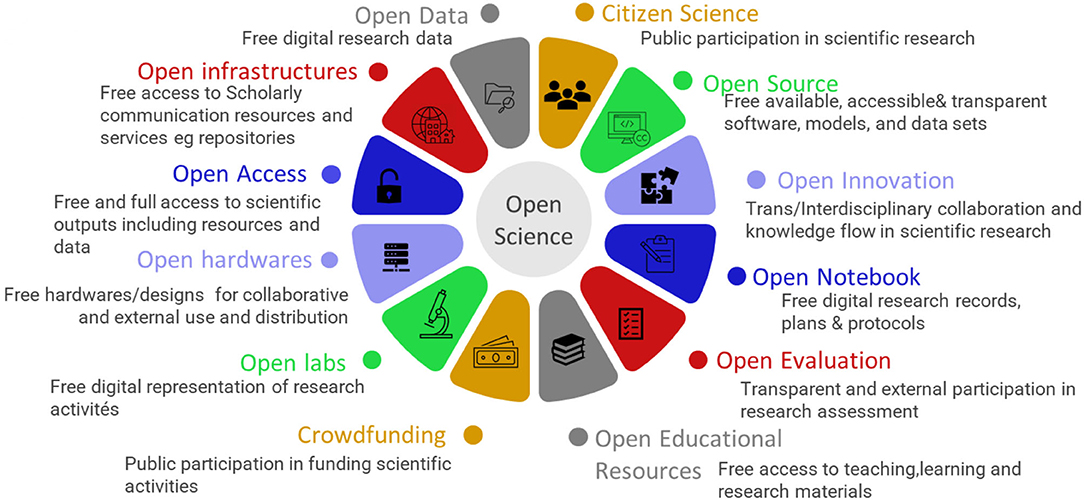| marp | theme | paginate | license | title | author | ||||||||||||||
|---|---|---|---|---|---|---|---|---|---|---|---|---|---|---|---|---|---|---|---|
true |
marp-theme_dataplant-ceplas-mibinet-ccby |
true |
[CC-BY 4.0](https://creativecommons.org/licenses/by/4.0/) |
RDM Fundamentals |
|
Dominik Brilhaus Sept 20th, 2023
Hartmann, Thomas. (2019). Rechtsfragen: Institutioneller Rahmen und Handlungsoptionen für universitäres FDM. Zenodo. https://doi.org/10.5281/zenodo.2654306
- Gold: Published in an open-access journal that is indexed by the DOAJ.
- Green: Toll-access on the publisher page, but there is a free copy in an OA repository.
- Hybrid: Free under an open license in a toll-access journal.
- Bronze: Free to read on the publisher page, but without a clearly identifiable license.
- Closed: All other articles, including those shared only on an Academic Social Network or in Sci-Hub.
Piwowar H et al. (2018), PeerJ https://doi.org/10.7717/peerj.4375
Okafor et al. (2022) https://doi.org/10.3389/frma.2022.855198, Figure 1
Check out: https://creativecommons.org/about/cclicenses/
adapted from https://wiki.creativecommons.org/images/0/01/6licenses-folded.pdf
GDPR: General Data Protection Regulation DS-GVO (german): Datenschutz-Grundverordnung
- MTA: material transfer agreement
- Nagoya Protocol: https://www.cbd.int/abs/about/
- DSI: Digital sequence information
https://www.gida-global.org/care
https://datascience.codata.org/articles/10.5334/dsj-2020-043/
Hiemenz, Bea & Kuberek, Monika (2018) http://dx.doi.org/10.14279/depositonce-7521
<style scoped> section{font-size: 25px;} </style>
- Deutsche Forschungsgemeinschaft (2015): DFG Guidelines on the Handling of Research Data
- Amtliche Mitteilungen der Universität zu Köln AM 07/2018: Leitlinie zum Umgang mit Forschungsdaten
- Amtliche Bekanntmachung der Heinrich-Heine-Universität Nr. 43/2022: Forschungsdaten-Richtlinie
- Leitlinie zum Umgang mit Forschungsdaten im Forschungszentrum Jülich 05/2019
- Senat der Max-Planck-Gesellschaft (2009): Regeln zur Sicherung guter wissenschaftlicher Praxis
- Covers the full research data lifecycle
- Frequently updated as your project develops
- Required to different extents by funding agencies (e.g. DFG, Horizon Europe, BMBF, BMEL, ... )
- Data Stewardship Wizard https://ds-wizard.org/
- RDMO https://rdmorganiser.github.io/ (e.g. https://rdmo.hhu.de)
- Dataplan: https://dmpg.nfdi4plants.org
Check out the Elixir RDMkit for more
<style scoped> table { width: 100%; height: 400; } </style>
| Repository | Description | Biological data domain |
|---|---|---|
| EBI-ENA | European Nucleotide Archive | genome / transcriptome sequences |
| EBI-ArrayExpress | Archive of Functional Genomics Data | transcriptome |
| EBI-MetaboLights | Database of Metabolomics | metabolome |
| EBI-PRIDE | PRoteomics IDEntifications Database | proteome |
| EBI-BioImage Archive | Stores and distributes biological images | imaging, microscopy |
| e!DAL-PGP | Plant Genomics & Phenomics Research Data Repository | phenome |
| NCBI-GEO | Gene Expression Omnibus | transcriptome |
| NCBI-GenBank | Genetic Sequence Database | genome |
| NCBI-SRA | Sequence Read Archive | genome / transcriptome sequences |
Domain-specific >> Generic >> Institutional
Find repositories at:
<style scoped> section {font-size: 25px;} </style>
Good
- Assign PIDs / DOIs
- Long-term accessible
- Data type specific
- Apply metadata standards
- Usually recommended / required by journals
- Mostly accepted by the community
Intermediate
- User-friendliness
- Different metadata schema
- Complex and versatile submission routines
Good
- Allow publication of any kind of data Assign PIDs / DOIs
- Long-term accessible
- Very simple to use
Intermediate
- Only generic / high-level metadata schema
- Limited reusability
https://doi.org/10.1093/plcell/koab243
- Long-term findability
- Make data, digital objects, people, … uniquely identifiable
- Diminish “dead links”
- Cope with name changes
Ideally, PIDs are
- Stable and permanent
- Location-independent
- Globally unique and valid
- Addressable (citable)
- Clickable (resolvable)
Adapted from https://www.ebi.ac.uk/rdf/documentation/good_practice_uri/
- https://www.doi.org
- https://www.orcid.org
- https://pidservices.org/
- https://datacite.org
- https://www.project-freya.eu/en
| Backup | Archive | |
|---|---|---|
| Storage type | Short-, mid-term | Long-term |
| Purpose | Disaster recovery | Long-term storage, compliance |
| Reason | Duplication | Migration |
| Usage | Work in progress | Cold, Unused data |
| Changes | Short-term updates | No updates |
| Trend | Cyclic, Replacement | Growing |
| Latency | Short/Costly | High/Cheaper |
It’s good practice to document:
- What was changed?
- Who is responsible?
- When did it happen?
- Why the changes?
- by file name (_v1, _v2)
- cloud services
- dropbox, icloud, gdrive
- distributed version control system
- e.g. Git
✓ Documents
✓ Small data
✓ Presentations
X Code
X Data analytical projects
X Big (“raw”) data
<style scoped> section {font-size: 25px;} </style>
- C3RDM: https://fdm.uni-koeln.de/en/home
- Data storage and sharing: https://rrzk.uni-koeln.de/daten-speichern-teilen
- HPC: https://rrzk.uni-koeln.de/hpc-projekte
- service overview: https://fdm.uni-koeln.de/en/rdm-services/service-catalogue
- RDM Competence Center: https://www.fdm.hhu.de
- Support for research including HPC: https://www.zim.hhu.de/servicekatalog/forschungsunterstuetzung
- Processing & storing data: https://www.zim.hhu.de/servicekatalog/rechnen-und-speichern
Slides presented here include contributions by
- name: Dominik Brilhaus github: https://github.com/brilator orcid: https://orcid.org/0000-0001-9021-3197
- name: Hajira Jabeen github: https://github.com/HajiraJabeen orcid: https://orcid.org/0000-0003-1476-2121











